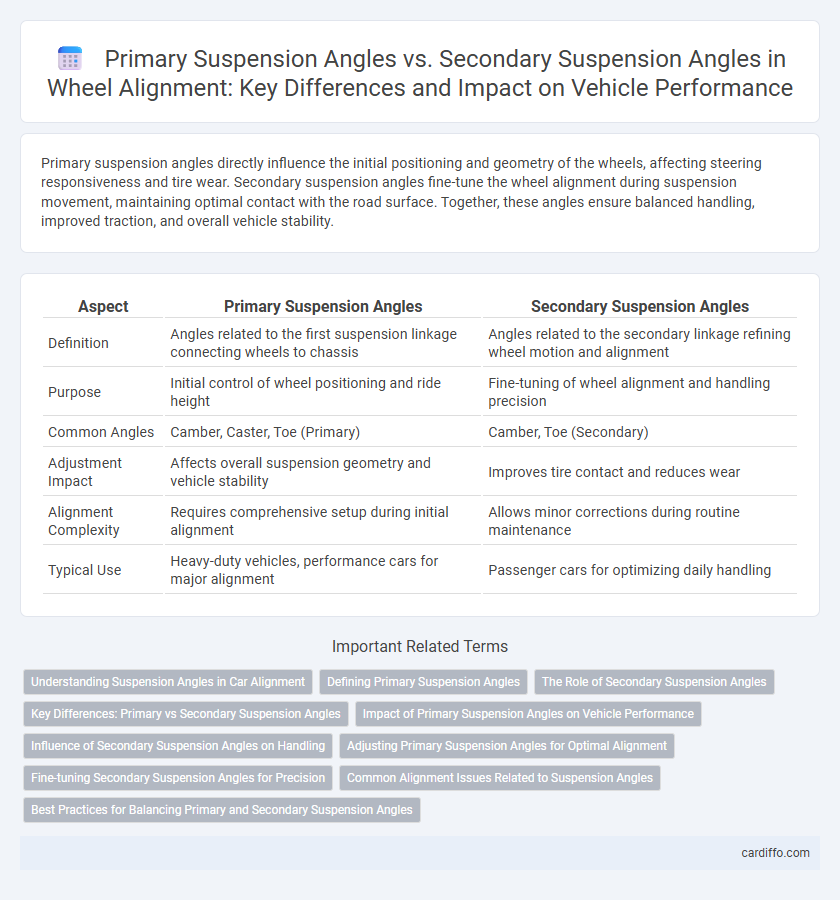Primary suspension angles directly influence the initial positioning and geometry of the wheels, affecting steering responsiveness and tire wear. Secondary suspension angles fine-tune the wheel alignment during suspension movement, maintaining optimal contact with the road surface. Together, these angles ensure balanced handling, improved traction, and overall vehicle stability.
Table of Comparison
| Aspect | Primary Suspension Angles | Secondary Suspension Angles |
|---|---|---|
| Definition | Angles related to the first suspension linkage connecting wheels to chassis | Angles related to the secondary linkage refining wheel motion and alignment |
| Purpose | Initial control of wheel positioning and ride height | Fine-tuning of wheel alignment and handling precision |
| Common Angles | Camber, Caster, Toe (Primary) | Camber, Toe (Secondary) |
| Adjustment Impact | Affects overall suspension geometry and vehicle stability | Improves tire contact and reduces wear |
| Alignment Complexity | Requires comprehensive setup during initial alignment | Allows minor corrections during routine maintenance |
| Typical Use | Heavy-duty vehicles, performance cars for major alignment | Passenger cars for optimizing daily handling |
Understanding Suspension Angles in Car Alignment
Primary suspension angles, including camber, caster, and toe, directly influence the initial contact and handling characteristics of the vehicle by adjusting how tires interact with the road surface. Secondary suspension angles, such as thrust angle and setback, affect the alignment and tracking precision by addressing chassis and frame geometry irregularities. Understanding the relationship between primary and secondary suspension angles is essential for optimizing tire wear, vehicle stability, and steering response during car alignment procedures.
Defining Primary Suspension Angles
Primary suspension angles refer to the initial alignment settings of the vehicle's suspension components, including caster, camber, and toe angles, which directly influence handling, stability, and tire wear. These angles are measured relative to the vehicle's frame and play a crucial role in maintaining proper wheel orientation during straight-line driving. Correctly defining primary suspension angles ensures optimal contact between tires and road surface, enhancing overall vehicle performance.
The Role of Secondary Suspension Angles
Secondary suspension angles play a crucial role in fine-tuning vehicle alignment by controlling camber and toe changes during suspension travel. Unlike primary suspension angles, which are fixed and determine static alignment, secondary angles allow dynamic adjustments that improve handling stability and tire contact with the road. Optimizing secondary suspension angles enhances ride comfort and reduces uneven tire wear by adapting to varying driving conditions.
Key Differences: Primary vs Secondary Suspension Angles
Primary suspension angles refer to the mounting angles of the suspension components directly connected to the vehicle chassis, influencing ride quality and initial wheel alignment. Secondary suspension angles pertain to the geometry of suspension linkages interacting with primary components, affecting dynamic handling and stability during motion. Key differences include their roles in load distribution, with primary angles managing static alignment and secondary angles fine-tuning dynamic wheel positioning.
Impact of Primary Suspension Angles on Vehicle Performance
Primary suspension angles, such as camber, caster, and toe measured at the wheel hub, directly influence the tire's contact patch and steering response, playing a critical role in vehicle handling and stability. Incorrect primary angles cause uneven tire wear, reduced traction, and compromised braking efficiency, significantly impacting overall vehicle performance. Optimizing these angles ensures improved ride quality, precise steering feedback, and enhanced safety under various driving conditions.
Influence of Secondary Suspension Angles on Handling
Secondary suspension angles critically influence vehicle handling by affecting the dynamic camber and toe changes during suspension travel. These angles determine how tire contact patches vary under load, directly impacting stability and cornering response. Optimizing secondary suspension geometry enhances grip and steering precision, crucial for performance and safety.
Adjusting Primary Suspension Angles for Optimal Alignment
Adjusting primary suspension angles such as camber, caster, and toe is crucial for optimal vehicle alignment, directly affecting handling, tire wear, and stability. Precision in setting these angles ensures the suspension components operate within designed parameters, improving contact patch efficiency and steering response. Fine-tuning primary angles reduces the need for secondary suspension adjustments, streamlining alignment maintenance and enhancing overall driving performance.
Fine-tuning Secondary Suspension Angles for Precision
Fine-tuning secondary suspension angles enhances vehicle alignment precision by compensating for dynamic changes during driving, ensuring optimal tire contact and handling stability. Secondary suspension angles, such as caster and toe during motion, influence steering responsiveness and tire wear more sensitively than primary angles set at rest. Accurate adjustment of these dynamic factors improves overall ride quality and safety by maintaining consistent alignment under varying load and road conditions.
Common Alignment Issues Related to Suspension Angles
Misalignment between primary suspension angles, such as camber and caster, and secondary suspension angles like toe can lead to uneven tire wear and compromised vehicle handling. Incorrect primary suspension angles often cause premature tire degradation, while secondary angles primarily affect steering stability and responsiveness. Ensuring precise adjustment of both suspension angle categories is essential for optimal alignment and vehicle performance.
Best Practices for Balancing Primary and Secondary Suspension Angles
Balancing primary and secondary suspension angles is critical for optimal vehicle alignment, ensuring both stability and handling precision. Best practices involve carefully adjusting camber and caster angles within manufacturer specifications to harmonize tire contact patches and minimize uneven wear. Utilizing advanced alignment tools and real-time feedback systems enables technicians to fine-tune these angles, enhancing ride comfort and extending suspension component lifespan.
Primary Suspension Angles vs Secondary Suspension Angles Infographic

 cardiffo.com
cardiffo.com